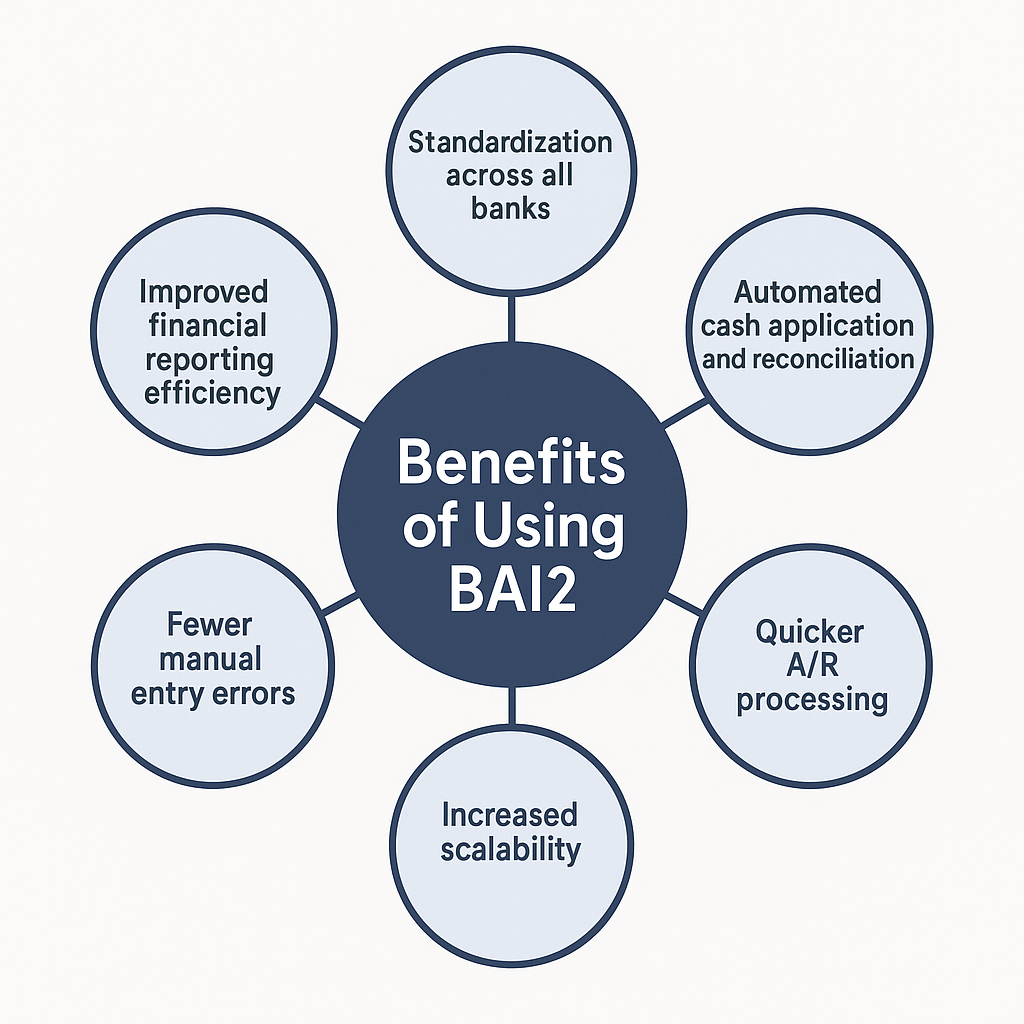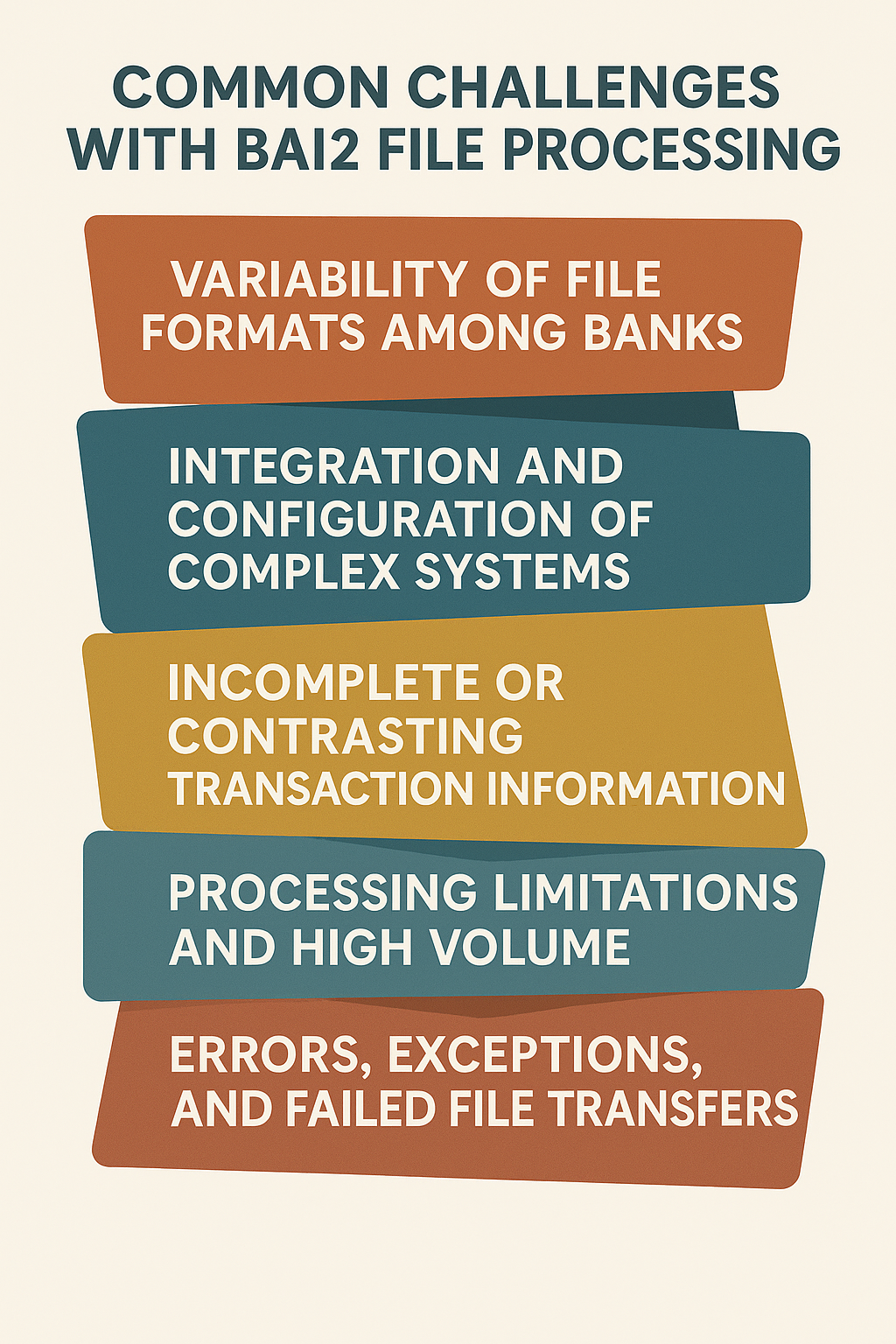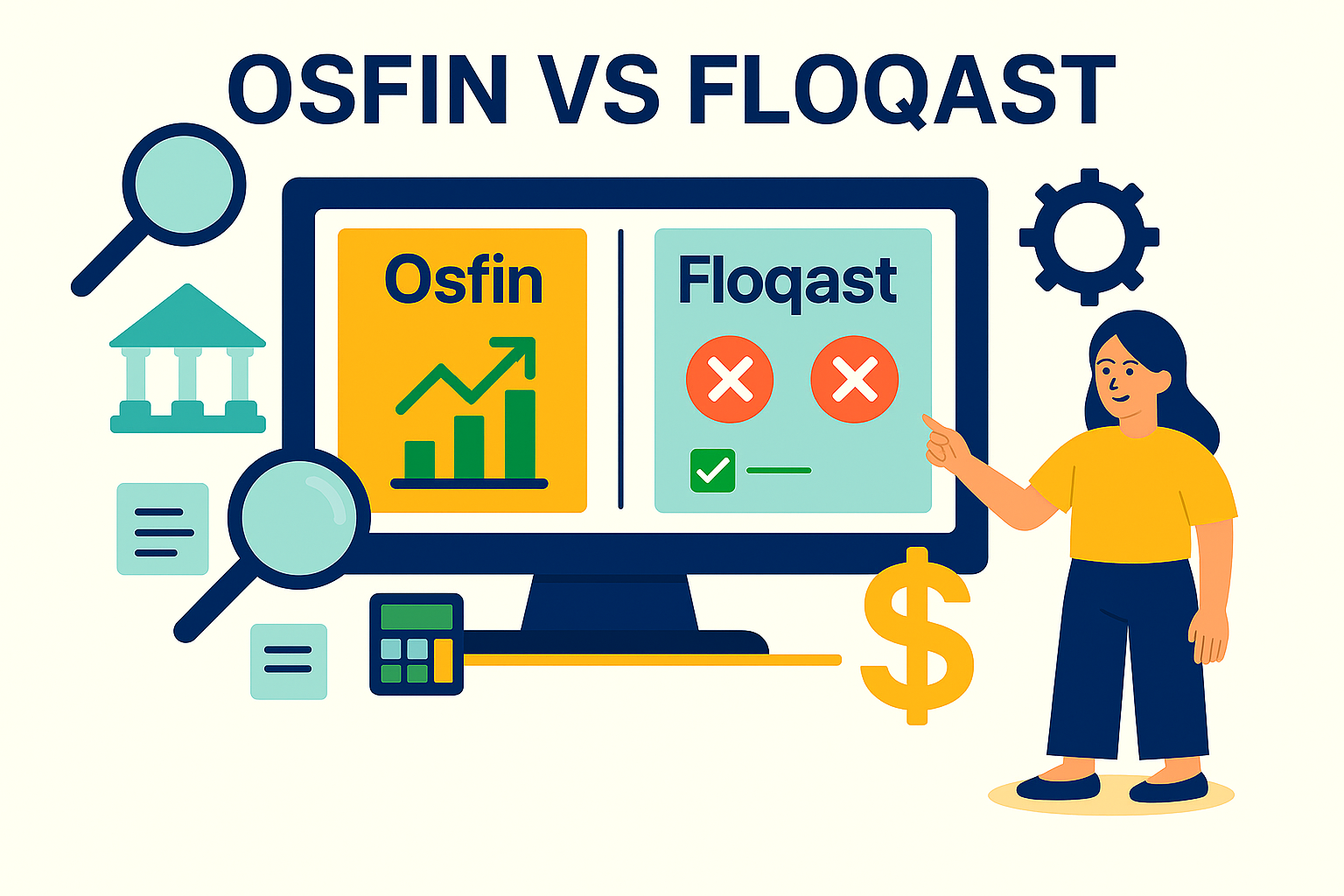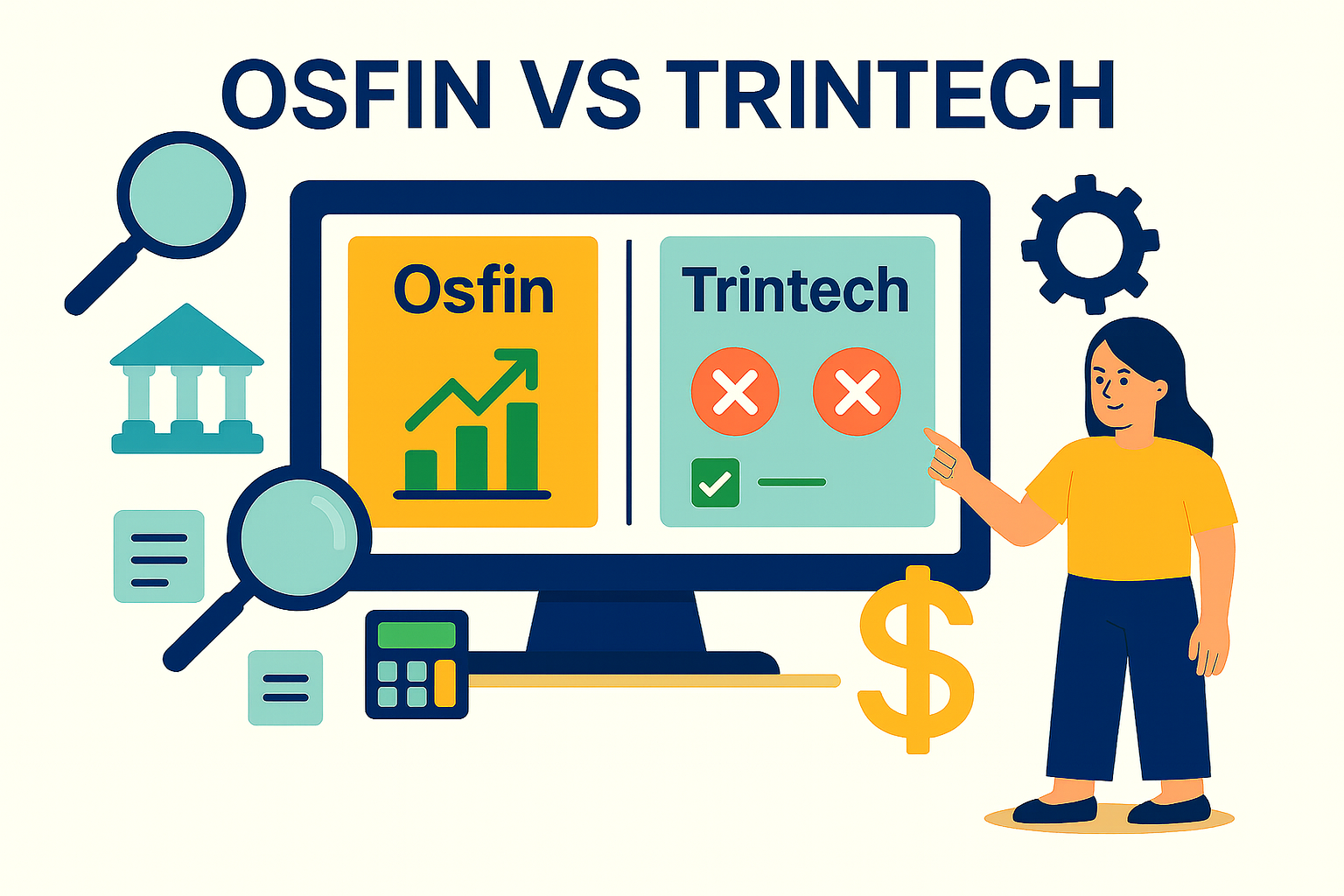What Is BAI2? A Guide to the Bank Administration Format for Reporting
Ever wondered how banks keep track of millions of transactions every single day without breaking a sweat? BAI2 is at play.
The BAI2 was created by the Bank Administration Institute (BAI) to develop consistent and efficient financial reporting systems, with the aim of preventing confusion and compatibility issues. The BAI2 file provides a standardized format for sharing financial information between banks and businesses. In the modern financial age, this helps eliminate the confusion caused by bank-specific formats.
Today, the BAI2 file format forms the foundation of modern financial operations. It facilitates quicker reconciliation, easier system integration, and real-time visibility for global banking networks. We’ll cover how BAI2 achieves it all in this article.
What this blog covers:
- What the BAI2 file format is and how it standardizes bank statement reporting for cash management.
- Key structure and record types in a BAI2 file (headers, account identifiers, transaction details, trailers).
- Why businesses use BAI2 files: automatic bank statement import, reconciliation, cash visibility.
- Challenges and best practices for implementing and processing BAI2 formats.
- How automation and reconciliation tools like Osfin handle BAI2 for faster and accurate cash-management workflows.
Definition of BAI2
The BAI2 file, with its meaning rooted in standardized bank reporting, helps make financial data exchanges smoother. It is a set of codes introduced by the Bank Administration Institute, USA. The BAI2 allows for consistent and automated reporting of bank account information across financial institutions and businesses.
It simplifies cash management by formatting financial data, such as credits and debits, into standardized codes. BAI2 files are usually imported into ERP or treasury systems of a company to assist in automating bank reconciliation and improving visibility into account activity.
Compared to its predecessor, the BAI file format, the BAI2 provides greater compatibility, greater automation, and faster processing, making it a core tool in the modern financial world. In the next section, we’ll see how.
Importance of BAI2
What makes the BAI2 important? Banks and financial institutions benefit from its adoption, as it simplifies a plethora of processes.
Here, we detail how and why:
1. Standardized Reporting
The structured reporting enabled by BAI2 files is a major benefit. A standard format is key for exchange of information between institutions.
2. Automation of Bank Reconciliation
Prior to the introduction of BAI2, reconciliation of bank statements with internal ledgers was done manually. Now, this process is largely automated. ERP and treasury systems, especially with reconciliation automation tools, can read and interpret transaction data, which helps reduce reconciliation time and circumvent manual errors completely.
3. Faster Matching of Bank Transactions
BAI2 provides structured bank data that is required to identify and match incoming payments.When used in combination with transaction matching automation software, this structured data format allows for acceleration of the transaction matching process in a bank.. This simplifies reconciliation, thus reducing manual effort and improving accuracy.
5. Strategic Financial Management
The accurate and consistent information in BAI2 files supports a wide range of operations: audit compliance, financial reporting, banking fee analysis and planning investments. Consequently, it allows for data-driven decision-making and stronger governance throughout the organization.
BAI2 is a foundation tool for operational efficiency and finance management in institutions. With automation tools such as Osfin, organizations can transform complicated BAI2 workflows into a streamlined process, which not only improves accuracy and speed, but also financial control.

Understanding BAI2 Format
A question might arise: what is BAI format? The BAI2 file format has, in fact, a precise and hierarchical structure. It includes a series of structured codes that represent account balances, transaction types, timestamps, and other important data. Each line in the file has a specific layout that allows software systems to review and process the data automatically.
Files with the .bai2 extension are made up of structured records, each of which has specific codes and fields that follow fixed rules. These files are usually encrypted and transmitted through secure channels. As a result, BAI2 files establish data integrity and confidentiality. Let’s dive into the file structure in the next section.
Explanation of BAI2 File Structure
Each BAI2 file is composed of multiple records that are organized in a hierarchical structure. With this, target systems can process the data reliably. Here’s a table explaining this structure:
Each record is separated with commas. BAI2 files contain records with a maximum of 250 characters and the fields within those records follow specific lengths and formats. Here’s an illustration:
- A Record Type could occupy the first 6 characters.
- A name field may be 15 characters.
- A date can be expressed in 8 digits (YYYYMMDD).
This consistency enables data to be read line-by-line, without room for misinterpretation, even between different vendors and banks.
The strength of the BAI2 format lies in its use of standard transaction codes, which are three-digit numbers that define each financial transaction. Some of such BAI2 format examples are:
These codes allow treasury systems and automation softwares to automatically interpret transactions, categorize them, and match them to internal accounts.
BAI2 File Format Example
This is a BAI2 file format example, based on the BAI Cash Management Standards:
Here’s a breakdown of the BAI2 file format sample:
- 01: File Header – Identifies the sender, date, and currency.
- 02: Group Header – Represents a group of accounts under one originator.
- 03: Account Header – Lists the account number and opening balance.
- 16: Transaction Detail – Each transaction is listed with a BAI Code and amount.
- 49: Account Trailer – Totals all transactions for that account.
- 98: Group Trailer – Summarizes totals for the group.
- 99: File Trailer – Provides totals for the entire file.
Each line begins with a record code and is in a comma-limited structure. This is convenient for computerized systems like Osfin to read and process a large amount of bank information for checking and reporting.
{{banner1}}
Why is BAI2 Critical for Payment Reconciliation?
In banking operations that include large transaction volumes, manual reconciliation of payments is impractical and can lead to errors. By using BAI2 files, banks and treasury departments can automatically match funds and disbursements.
Instead of processing different file format types from different banks, BAI2 standardizes how payment data is sent. This eliminates manual entry, minimizes errors, and makes internal records reconcile with bank statements more accurately. It also allows real-time identification of duplicate or failed transactions, which reduces risk and increases control. These features converge onto a more efficient, audit-ready payment reconciliation process
Benefits of Using BAI2
With the features of the BAI2 in mind, let’s see how the adoption of the BAI2 file format benefits financial teams and institutions. Here are the significant benefits:
1. Standardization across all banks
BAI2 provides a uniform file format regardless of the region or the bank.
2. Automated reconciliation
BAI2 data enables ERP or TMS systems and their associated automation tools to reconcile transactions, with minimal manual work.
3. Quicker A/R processing
BAI2 can decrease accounts receivable processing by large margins.
4. Human resource optimization
Financial institutions can process more transactions without adding the headcount associated with manual reconciliations. This frees up staff to work on higher-value tasks and decision-making.
5. Fewer manual entry errors
With automated data ingestion, there is reduced potential for human error. For financial institutions, this results in cleaner books and fewer reconciliation issues.
6. Improved financial reporting efficiency
Accurate, real-time transaction data increases the internal reporting cycles during month, quarter, and year-end closes.

By transforming raw banking data into structured, usable data, BAI2 allows finance teams to respond with high speed, accuracy, and confidence. With automation tools like Osfin, the full power of BAI2 can be utilized, accelerating each aspect of your financial operations.
{{banner2}}
Implementing BAI2 in Your Organization
Adopting BAI2 file format is a strategic move that can have a significant impact on an institution, but only if it is implemented well. Here are ways to ensure a proper implementation of BAI2:
1. Secure and Reliable File Transfer Process
To ensure integrity of data is maintained, secure file transfers should be established from the bank through SFTP, FTPS, or API. Keep in mind that tools like Osfin can automatically parse BAI2 files.
2. Mapping and Integration of BAI2 Data with Internal Systems
BAI codes should be mapped to the internal general ledger or ERP fields for consistent processing. Integration with tools such as ERP, TMS, and AR systems can provide you with full visibility on your financial data.
3. Automation of Reconciliation
Reconciliation should be automated using rules and logic-based matching. Exception workflows should be designed to process unmatched or flagged transactions promptly.
4. Validate Files and Ensure Data Accuracy
Incoming files for errors or missing information should always be verified before importing. This prevents errors and ensures financial records stay clean.
5. Analyze, Test, and Optimize Your Setup
Before deploying, thorough testing should be performed with real or test files. Once results are received, the data should be used to gain insights into bank charges, and payment behavior.
With appropriate tools, and the right implementation approach, BAI2 can support faster reconciliation, cleaner data, and smarter cash management. In the next section, we’ll look at the other side of the coin.
Common Challenges with BAI2 File Processing
While BAI2 file format allows for effective financial data exchange, implementing and regular processing can cause technical and operational challenges like:
1. Variability of File Formats Among Banks
While BAI2 is standardized, banks can use it in varied ways. It can be used as proprietary codes or with inconsistent field structures. Such differences can make parsing, mapping, and automation challenging, if not properly controlled.
2. Integration and Configuration of Complex Systems
To integrate BAI2 with TMS or ERP, techniques like technical implementation, secure file transmission, and proper data mapping are involved. Data could be incorrectly classified or completely overlooked if installed and tested inappropriately.
3. Incomplete or Contrasting Transaction Information
Some BAI2 files contain incomplete descriptions or unclear remittance information. This will result in unbalanced transactions, or will require frequent manual intervention in the reconciliation process.
4. Processing Limitations and High Volume
Large enterprises with high volumes of transactions and financial data, can find it challenging to process BAI2 files effectively. Without preemptively optimizing for scale, financial operations can slow down before you know it.
5. Errors, Exceptions, and Failed File Transfers
Even with automation, unexpected issues like mismatched amounts or SFTP transfer failures can disrupt reconciliation. Without proper error-handling procedures, these issues can escalate into larger reporting inaccuracies.
With proper tools and planning, these are problems that can be managed. Osfin places the organization ahead by standardizing data intake, exception handling, and making BAI2 processing smooth, regardless of volume or complexity.

Automating BAI2 File Ingestion and Reconciliation with Osfin
BAI2 file reconciliation is the quickest solution to eliminate delays and mistakes, from a financial close. Osfin.ai is designed to integrate into and simplify this process. Here’s how Osfin fits into the bigger picture:
1. File Import Automation:
Osfin imports BAI2 files directly from 170+ connectors, FTP/SFTP, email, or APIs with no manual intervention, even handling non-standard format differences like JSON, XML, and CSVs.
2. Accurate Transaction Matching:
Osfin matches transactions across ledgers 100% accurately, marking duplicates and outliers, decreasing reconciliation time to minutes.
3. Complete Security and Compliance:
Osfin’s built-in controls ensure standards compliance like SOX controls, PCI DSS, and IFRS. Role-based access, encryption and two-factor authentications ensure maximum security.
4. Real-Time Visibility:
Osfin’s dashboards provide instant visibility of matching status and exceptions, enabling better control of cash flow and quicker financial decision-making.
5. No-Code Configuration and Insights
Osfin provides a no-code setup for building custom rules, complete with intuitive dashboards and AI-powered insights. In combination with expert support and insights, Osfin is ready to hit the ground at your organization.
By automating BAI2 file ingestion and reconciliation, banks and organizations can always stay one step ahead. Unlocking its full potential requires the right tools to manage it efficiently, and Osfin is equipped with the right set of tools to enable it.
{{banner3}}
FAQs on BAI2
1.What is the difference between MT940 and BAI2?
MT940 is a SWIFT message format commonly used in Europe for providing end-of-day bank statements. BAI2 is an American standard format. It is built specifically for automated cash reporting, reconciliation, and integration across multiple banks and systems. This makes it more machine-friendly and suited for high-volume environments.
2.What is BAI2 used for?
BAI2 is used to electronically communicate detailed bank account information such as balances, deposits, withdrawals, and other transactions, in a standardized, structured format. It helps businesses automate reconciliation, improve cash flow visibility across accounts, and streamline financial reporting processes with greater accuracy and consistency.
3.What is the BAI2 format in SAP?
SAP is an ERP system used for the management of operations, finance, and data. In SAP, the BAI2 format is used within cash management and treasury modules to import electronic bank statements. It enables automated bank reconciliation, structured transaction processing, and accurate financial reporting.
4.Is BAI2 a txt file?
Yes, BAI2 files are plain text (.txt) files that use a structured, comma-separated format. Each line follows a specific hierarchy and set of codes, making them easy for financial systems and softwares to parse, reconcile, and automate reporting across accounts.
5.What is the difference between BAI and BAI2 format?
BAI2 is an improved version of the original BAI format, designed to support more detailed reporting and better automation. The BAI file meant some basic cash management data. BAI2 introduced standardization, while making easier reconciliation and integration possible.


